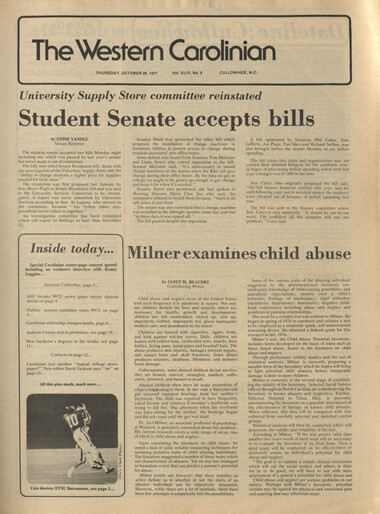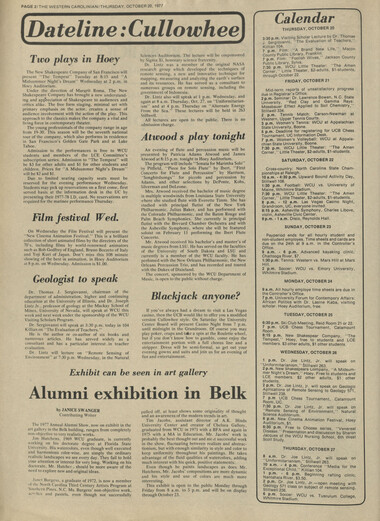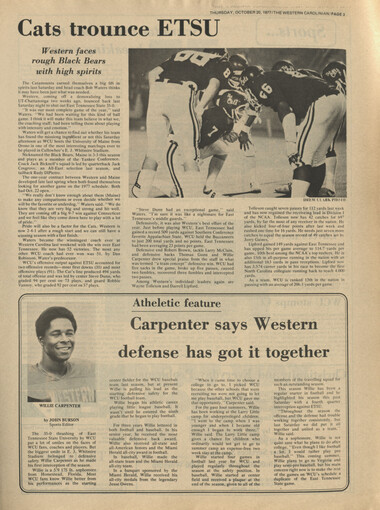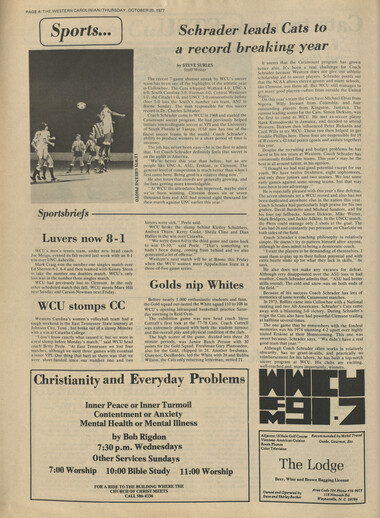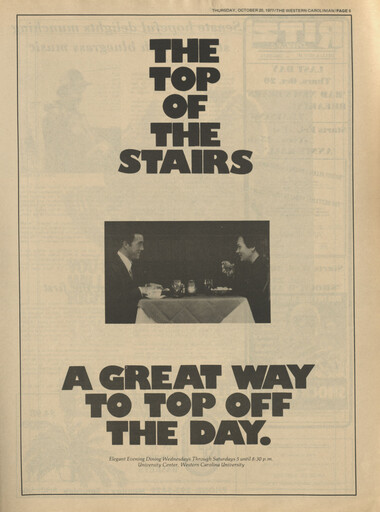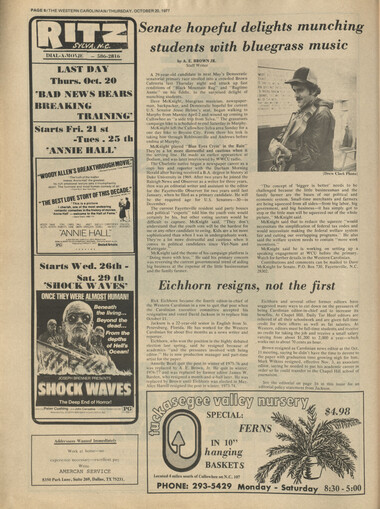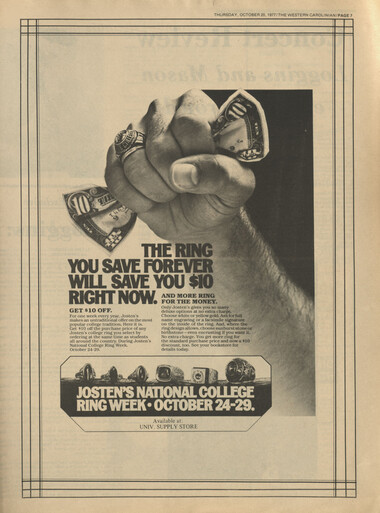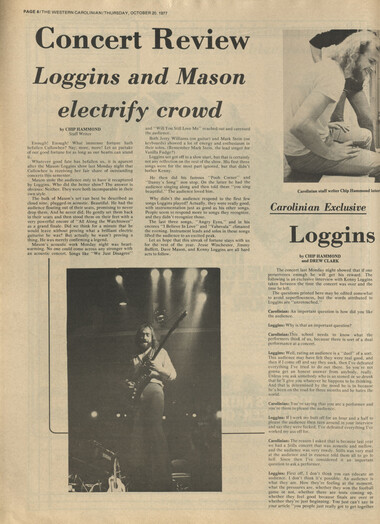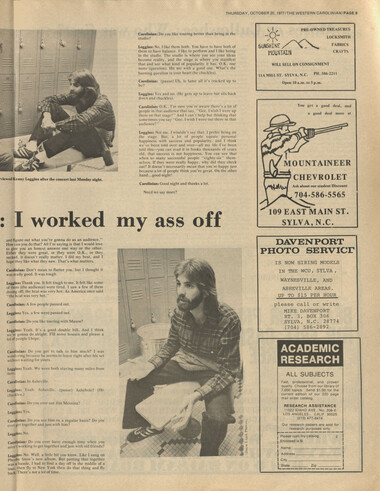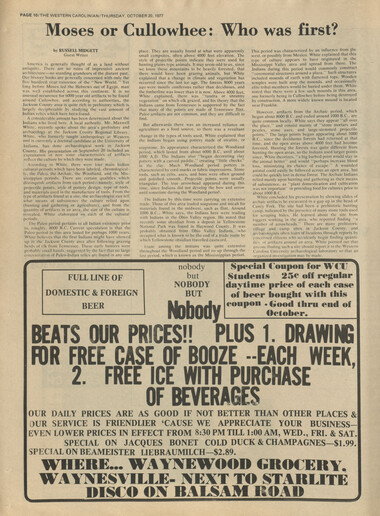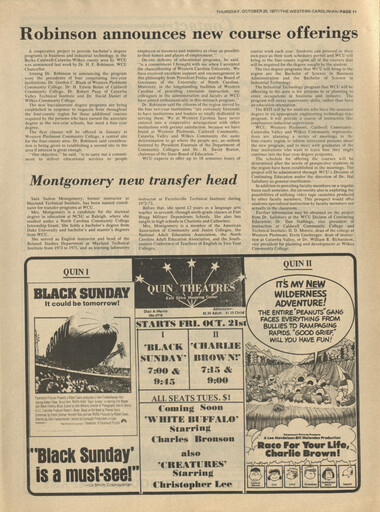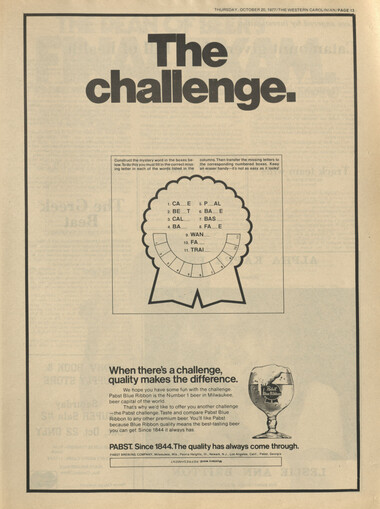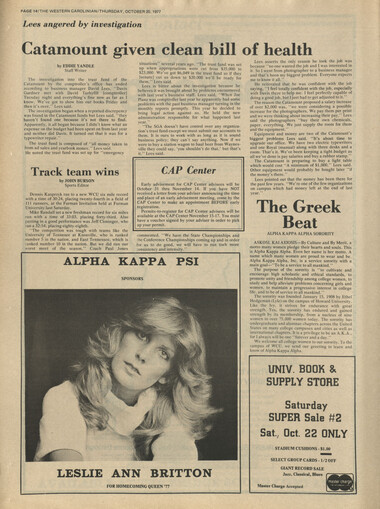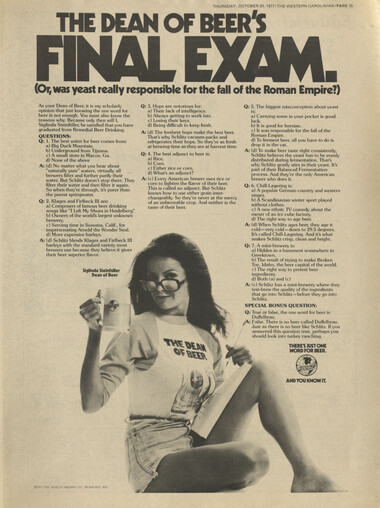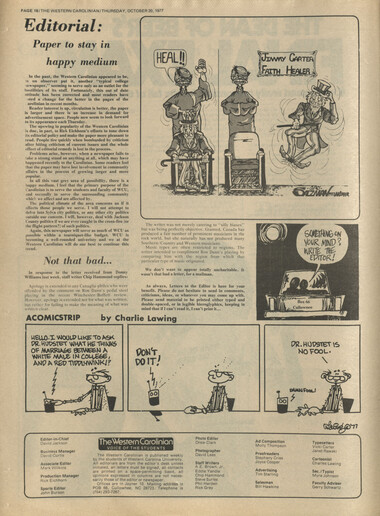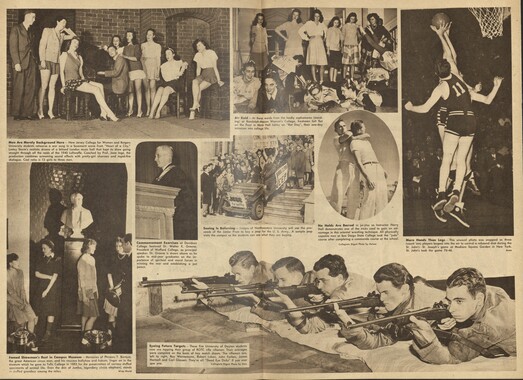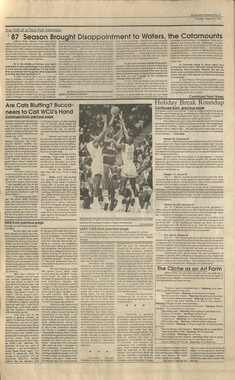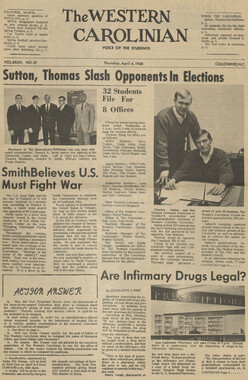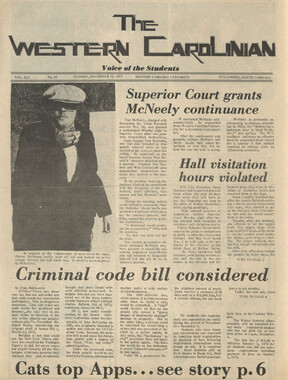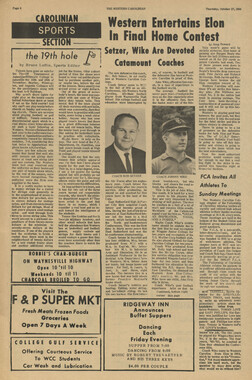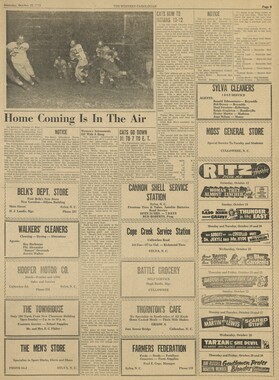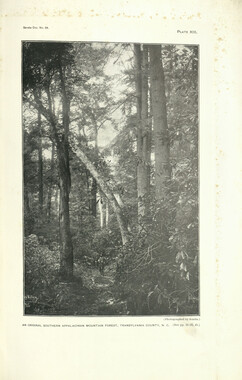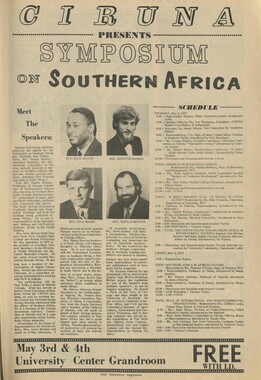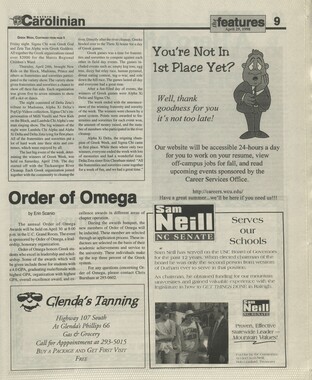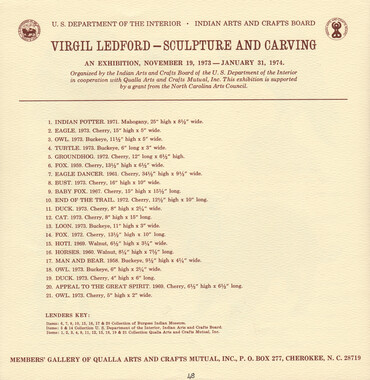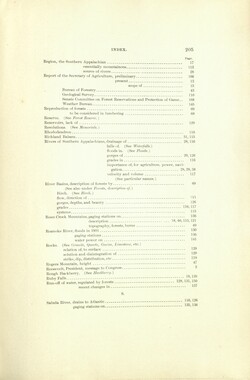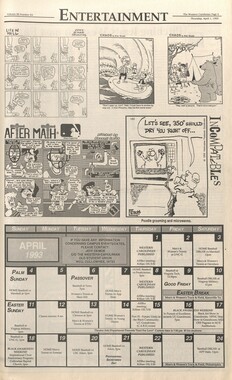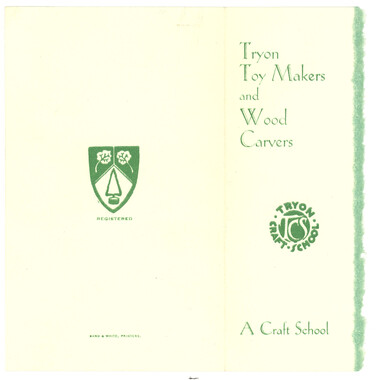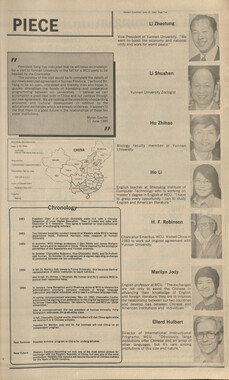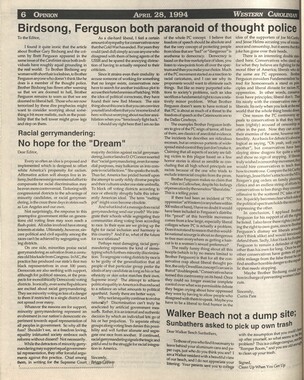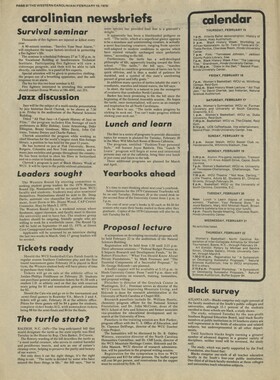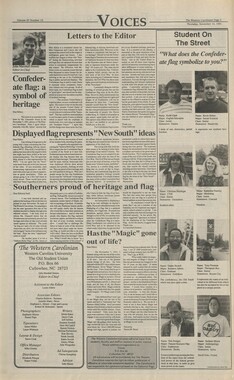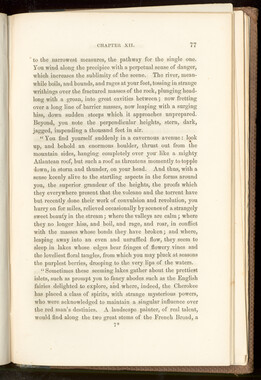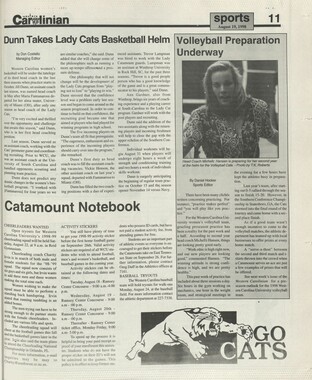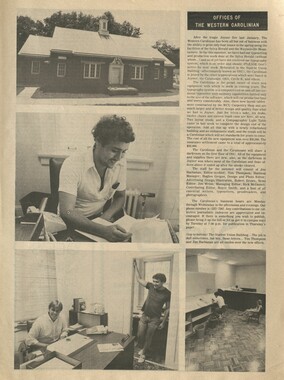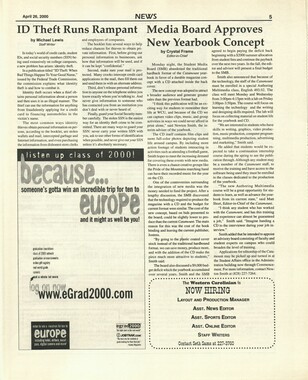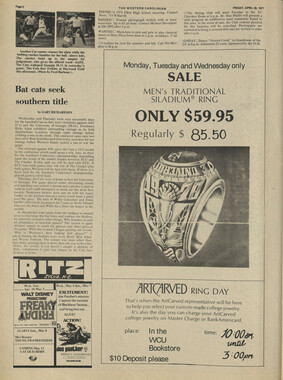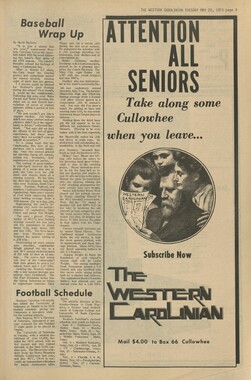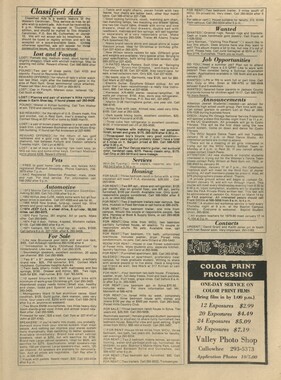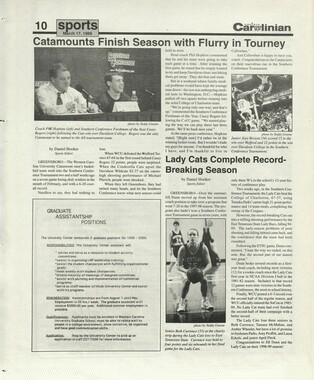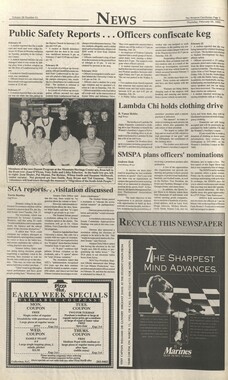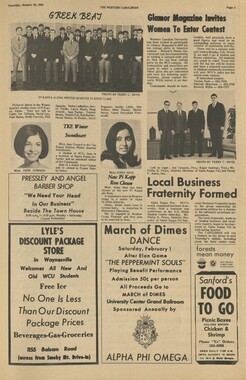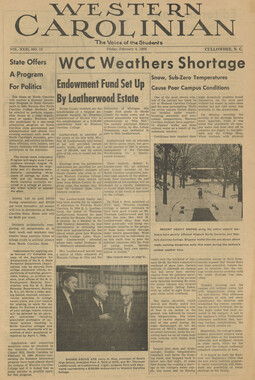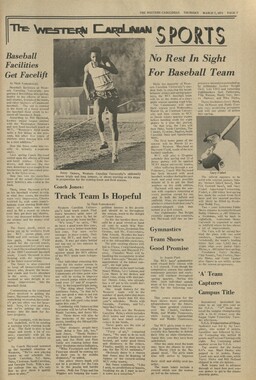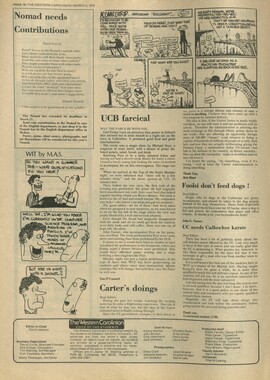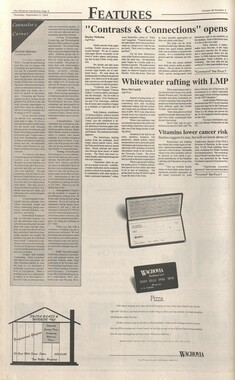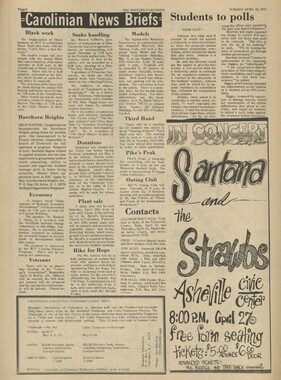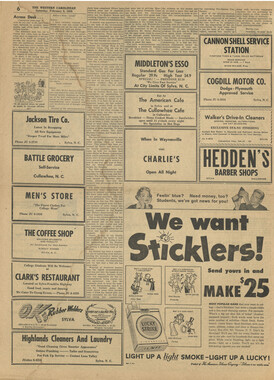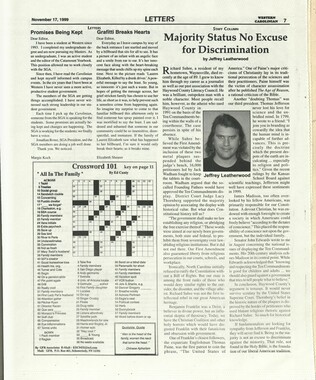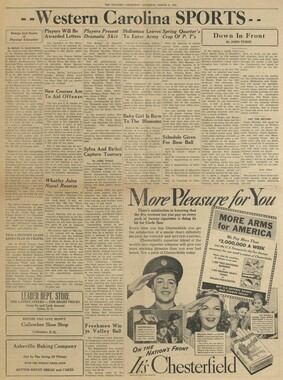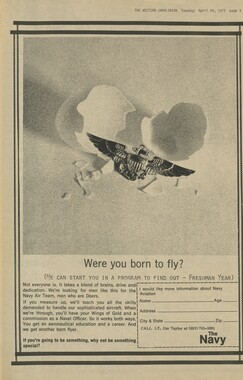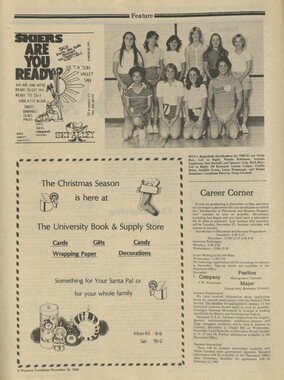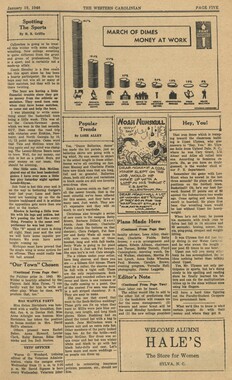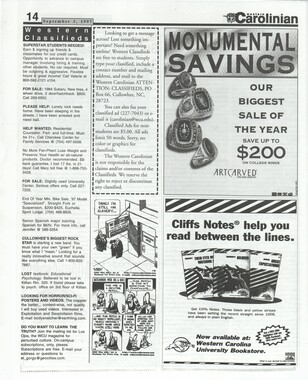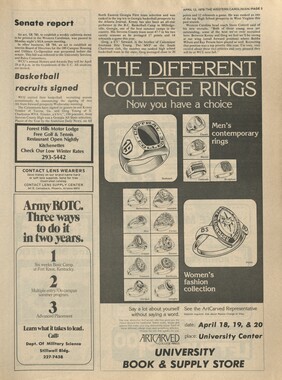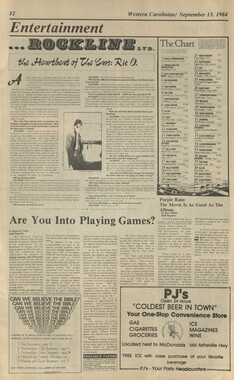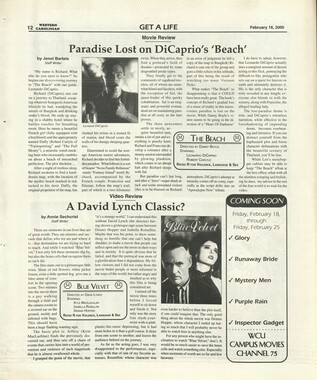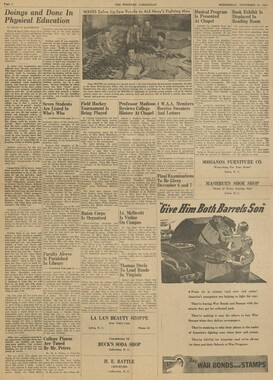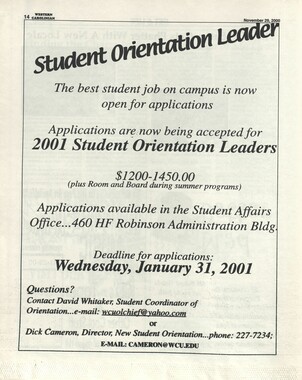Western Carolina University (20)
View all
- Canton Champion Fibre Company (2308)
- Cherokee Traditions (293)
- Civil War in Southern Appalachia (165)
- Craft Revival (1942)
- Great Smoky Mountains - A Park for America (2767)
- Highlights from Western Carolina University (430)
- Horace Kephart (941)
- Journeys Through Jackson (154)
- LGBTQIA+ Archive of Jackson County (26)
- Oral Histories of Western North Carolina (314)
- Picturing Appalachia (6772)
- Stories of Mountain Folk (413)
- Travel Western North Carolina (160)
- Western Carolina University Fine Art Museum Vitreograph Collection (129)
- Western Carolina University Herbarium (92)
- Western Carolina University: Making Memories (708)
- Western Carolina University Publications (2283)
- Western Carolina University Restricted Electronic Theses and Dissertations (146)
- Western North Carolina Regional Maps (71)
- World War II in Southern Appalachia (131)
University of North Carolina Asheville (6)
View all
- Allanstand Cottage Industries (62)
- Appalachian National Park Association (53)
- Bennett, Kelly, 1890-1974 (1388)
- Berry, Walter (76)
- Brasstown Carvers (40)
- Carver, George Washington, 1864?-1943 (26)
- Cathey, Joseph, 1803-1874 (1)
- Champion Fibre Company (233)
- Champion Paper and Fibre Company (297)
- Cherokee Indian Fair Association (16)
- Cherokee Language Program (22)
- Crowe, Amanda (40)
- Edmonston, Thomas Benton, 1842-1907 (7)
- Ensley, A. L. (Abraham Lincoln), 1865-1948 (275)
- Fromer, Irving Rhodes, 1913-1994 (70)
- George Butz (BFS 1907) (46)
- Goodrich, Frances Louisa (120)
- Grant, George Alexander, 1891-1964 (96)
- Heard, Marian Gladys (60)
- Kephart, Calvin, 1883-1969 (15)
- Kephart, Horace, 1862-1931 (313)
- Kephart, Laura, 1862-1954 (39)
- Laney, Gideon Thomas, 1889-1976 (439)
- Masa, George, 1881-1933 (61)
- McElhinney, William Julian, 1896-1953 (44)
- Niggli, Josephina, 1910-1983 (10)
- North Carolina Park Commission (105)
- Osborne, Kezia Stradley (9)
- Owens, Samuel Robert, 1918-1995 (11)
- Penland Weavers and Potters (36)
- Roberts, Vivienne (15)
- Roth, Albert, 1890-1974 (142)
- Schenck, Carl Alwin, 1868-1955 (1)
- Sherrill's Photography Studio (2565)
- Southern Highland Handicraft Guild (127)
- Southern Highlanders, Inc. (71)
- Stalcup, Jesse Bryson (46)
- Stearns, I. K. (213)
- Thompson, James Edward, 1880-1976 (226)
- United States. Indian Arts and Crafts Board (130)
- USFS (683)
- Vance, Zebulon Baird, 1830-1894 (1)
- Weaver, Zebulon, 1872-1948 (58)
- Western Carolina College (230)
- Western Carolina Teachers College (282)
- Western Carolina University (1794)
- Western Carolina University. Mountain Heritage Center (18)
- Whitman, Walt, 1819-1892 (10)
- Wilburn, Hiram Coleman, 1880-1967 (73)
- Williams, Isadora (3)
- Cain, Doreyl Ammons (0)
- Crittenden, Lorraine (0)
- Rhodes, Judy (0)
- Smith, Edward Clark (0)
- Appalachian Region, Southern (2399)
- Asheville (N.C.) (1917)
- Avery County (N.C.) (26)
- Blount County (Tenn.) (161)
- Buncombe County (N.C.) (1671)
- Cherokee County (N.C.) (283)
- Clay County (N.C.) (555)
- Graham County (N.C.) (233)
- Great Smoky Mountains National Park (N.C. and Tenn.) (510)
- Haywood County (N.C.) (3522)
- Henderson County (N.C.) (70)
- Jackson County (N.C.) (4692)
- Knox County (Tenn.) (25)
- Knoxville (Tenn.) (12)
- Lake Santeetlah (N.C.) (10)
- Macon County (N.C.) (420)
- Madison County (N.C.) (211)
- McDowell County (N.C.) (39)
- Mitchell County (N.C.) (132)
- Polk County (N.C.) (35)
- Qualla Boundary (981)
- Rutherford County (N.C.) (76)
- Swain County (N.C.) (2113)
- Transylvania County (N.C.) (247)
- Watauga County (N.C.) (12)
- Waynesville (N.C.) (73)
- Yancey County (N.C.) (72)
- Aerial Photographs (3)
- Aerial Views (60)
- Albums (books) (4)
- Articles (1)
- Artifacts (object Genre) (228)
- Bibliographies (1)
- Biography (general Genre) (2)
- Cards (information Artifacts) (38)
- Clippings (information Artifacts) (191)
- Crafts (art Genres) (622)
- Depictions (visual Works) (21)
- Design Drawings (1)
- Drawings (visual Works) (184)
- Envelopes (73)
- Facsimiles (reproductions) (1)
- Fiction (general Genre) (4)
- Financial Records (12)
- Fliers (printed Matter) (67)
- Glass Plate Negatives (381)
- Guidebooks (2)
- Internegatives (10)
- Interviews (812)
- Land Surveys (102)
- Letters (correspondence) (1013)
- Manuscripts (documents) (619)
- Maps (documents) (177)
- Memorandums (25)
- Minutes (administrative Records) (59)
- Negatives (photographs) (5835)
- Newsletters (1285)
- Newspapers (2)
- Occupation Currency (1)
- Paintings (visual Works) (1)
- Pen And Ink Drawings (1)
- Periodicals (193)
- Personal Narratives (10)
- Photographs (12976)
- Plans (maps) (1)
- Poetry (7)
- Portraits (1960)
- Postcards (329)
- Programs (documents) (151)
- Publications (documents) (2237)
- Questionnaires (65)
- Scrapbooks (282)
- Sheet Music (2)
- Slides (photographs) (402)
- Songs (musical Compositions) (2)
- Sound Recordings (796)
- Specimens (92)
- Speeches (documents) (15)
- Tintypes (photographs) (8)
- Transcripts (322)
- Video Recordings (physical Artifacts) (23)
- Vitreographs (129)
- Text Messages (0)
- A.L. Ensley Collection (275)
- Appalachian Industrial School Records (7)
- Appalachian National Park Association Records (336)
- Axley-Meroney Collection (2)
- Bayard Wootten Photograph Collection (20)
- Bethel Rural Community Organization Collection (7)
- Blumer Collection (5)
- C.W. Slagle Collection (20)
- Canton Area Historical Museum (2110)
- Carlos C. Campbell Collection (282)
- Cataloochee History Project (65)
- Cherokee Studies Collection (4)
- Daisy Dame Photograph Album (5)
- Daniel Boone VI Collection (1)
- Doris Ulmann Photograph Collection (112)
- Elizabeth H. Lasley Collection (1)
- Elizabeth Woolworth Szold Fleharty Collection (4)
- Frank Fry Collection (95)
- George Masa Collection (173)
- Gideon Laney Collection (452)
- Hazel Scarborough Collection (2)
- Hiram C. Wilburn Papers (28)
- Historic Photographs Collection (236)
- Horace Kephart Collection (861)
- Humbard Collection (33)
- Hunter and Weaver Families Collection (1)
- I. D. Blumenthal Collection (4)
- Isadora Williams Collection (4)
- Jesse Bryson Stalcup Collection (47)
- Jim Thompson Collection (224)
- John B. Battle Collection (7)
- John C. Campbell Folk School Records (80)
- John Parris Collection (6)
- Judaculla Rock project (2)
- Kelly Bennett Collection (1407)
- Love Family Papers (11)
- Major Wiley Parris Civil War Letters (3)
- Map Collection (12)
- McFee-Misemer Civil War Letters (34)
- Mountain Heritage Center Collection (4)
- Norburn - Robertson - Thomson Families Collection (44)
- Pauline Hood Collection (7)
- Pre-Guild Collection (2)
- Qualla Arts and Crafts Mutual Collection (12)
- R.A. Romanes Collection (681)
- Rosser H. Taylor Collection (1)
- Samuel Robert Owens Collection (94)
- Sara Madison Collection (144)
- Sherrill Studio Photo Collection (2558)
- Smoky Mountains Hiking Club Collection (616)
- Stories of Mountain Folk - Radio Programs (374)
- The Reporter, Western Carolina University (510)
- Venoy and Elizabeth Reed Collection (16)
- WCU Gender and Sexuality Oral History Project (32)
- WCU Mountain Heritage Center Oral Histories (25)
- WCU Oral History Collection - Mountain People, Mountain Lives (71)
- WCU Students Newspapers Collection (1744)
- Western North Carolina Tomorrow Black Oral History Project (69)
- William Williams Stringfield Collection (2)
- Zebulon Weaver Collection (109)
- African Americans (390)
- Appalachian Trail (35)
- Artisans (521)
- Cherokee art (84)
- Cherokee artists -- North Carolina (10)
- Cherokee language (21)
- Cherokee pottery (101)
- Cherokee women (208)
- Church buildings (167)
- Civilian Conservation Corps (U.S.) (110)
- College student newspapers and periodicals (1830)
- Dams (103)
- Dance (1023)
- Education (222)
- Floods (61)
- Folk music (1015)
- Forced removal, 1813-1903 (2)
- Forest conservation (220)
- Forests and forestry (921)
- Gender nonconformity (4)
- Great Smoky Mountains National Park (N.C. and Tenn.) (181)
- Hunting (38)
- Landscape photography (10)
- Logging (103)
- Maps (84)
- Mines and mineral resources (8)
- North Carolina -- Maps (18)
- Paper industry (38)
- Postcards (255)
- Pottery (135)
- Railroad trains (71)
- Rural electrification -- North Carolina, Western (3)
- School integration -- Southern States (2)
- Segregation -- North Carolina, Western (5)
- Slavery (5)
- Sports (452)
- Storytelling (245)
- Waterfalls -- Great Smoky Mountains (N.C. and Tenn.) (66)
- Weaving -- Appalachian Region, Southern (280)
- Wood-carving -- Appalachian Region, Southern (328)
- World War, 1939-1945 (173)
Western Carolinian Volume 43 Number 09
Item
Item’s are ‘child’ level descriptions to ‘parent’ objects, (e.g. one page of a whole book).
-
-
The^ster n Carolinian THURSDAY, OCTOBER 20, 1977 Vol. XLIII. No 9 CULLOWHEE.N.C. University Supply Store committee reinstated Student Senate accepts bills by EDDIE YANDLE Senate Reporter The student senate accepted two bills Monday night including one which was passed by last year's senate bin never made it out of committee. The bill, now titled Senate Resolution <>2I. deals with the investigation of tin- Univerisn Supply Store and the "ability to charge students a higher priee for supplies needed for their elass. " The resolution was first proposed last January by Sen. Bruee Pugh as Senate Resolution 5.14 and was sent to the University Serviees Committee to be investigated. A report was never submitted by University Serviees aeeording to Sen. Al Lagano, who served on the committee, because "Joe Yelton (then vice- president) never called us together." An investigation committee has been reinstated which will report its findings no later than December 12. Senator Mark Asa sponsored the other bill which proposed the installation of change machines in dormitory lobbies to permit access to change during resident assistants' non-office hours. Some debate was heard from Senators font McGuire and Linda Street who voiced opposition to the bill. Senator McGuire said, "It's unnecessary to install change machines in the dorms when the RAs will give change during their office hours. By the time we get to college' we ought to be grown up enough to get change ami keep it for when it's needed." Senator Street also mentioned she had spoken to Housing Director Moon (hat Sue who said, the companies refused to install them because, "there is no sali- place to put them." The senate was also reminded that a change machine was installed in the Albright laundry room last year but "in three days it was ripped off." The bill passed despite the opposition. A bill sponsored bv Senators Phil Cates, Tom I afferlv. Joe Plan/. Tim Sikes and Richard Sullins, was also brought before the senate Monday to cut deficit spending. fhe hill states that clubs and organizations may not exceed their allottted budgets for the academic year, in hopes of preventing deficit spending which sent last \ ear's budget OVCT $7,000 in the hole. Sen. Cates. who originally proposed the bill said, "the bill insures financial stability this year, and for each following year; not to mention money the students were cheated out of because of deficit spending last The bill was sent to the finance committee where Sen. Cites is verv optimistic. "It should be out in one week. I'm confident all the senators will see the problem." Cates said. Inside today., Special Carolinian center-page concert spread including an exclusive interview with Kenny Loggins... Dateline Cullowhee, page 2... ASU breaks WCU seven game soccer shutout streak on page 4... Fiddlin' senator candidate visits WCU on page Carolinian editorship changes hands, page 6... Jackson County rich in prehistory, see page 10.., Contacts on page 12... Carolinian just another "typical college newspaper?" New editor David Jackson says "no" on page 16... All this plus much, much more... Milner examines child abuse Cats destroy ETSU Buccaneers, see page 3... by JANET M.BEAUDRY Contributing Writer Child abuse and neglect occur in the United States with such frequency it is pandemic in nature. Not only are children denied the love and security which arc necessary for healthy growth and development, children are left unattended, locked up, tied up, improperly clothed, improperly fed, given inadequate medical care, and abandoned on the street. Children are burned with cigarettes, cigars, irons, and held against red-hot stoves. Daily, children are beaten with rubber hose, clothesline wire, boards, beer bottles, frying pans, metal pipes and baseball bats. The abuse produces skin injuries, damages internal organs, and causes bone and skull fractures. Some abuse produces seizures, deafness, blindness and massive brain damage. Unfortunately, some abused children do not survive: they are beaten, starved, strangled, stabbed, suffocated, drowned, and burned to death. Abused children often have an acute awareness of what is happening to them. In one case a four-year-old girl received repeated beatings from her mother's boyfriend. The child was reported to have frequently asked friends and relatives if mommy's boyfriend was trying to kill her. One afternoon when the boyfriend was baby-sitting for the mother, the beatings began and did not cease until the girl was dead. Dr. Joel Milner, an associate professor of psychology at Western, is genuinely concerned about this problem. His current research covers a wide range of areas, one of which is child abuse and neglect. Upon examining the literature on child abuse, he noted a lack of valid, reliable measuring techniques for assissing punative traits of child abusing individuals. The literature suggested a number of these traits which are characteristic of abusers. Yet no one has managed to formulate a test that can predict a person's potential for abuse. Milner points out however, that there remains an active debate as to whether or not the traits of an abusive individual can be objectively measured. However, while there are a lot of opinions, there have been few attempts to empirically test the possibilities. Some of the various traits of the abusing individual suggested by the aforementioned literature are: inadequate knowledge of child-rearing procedures and unrealistic expectations; anxiety over a child's behavior; feelings of inadequacy; rigid attitudes; impulsivity; dependency: immaturity: negative childhood experiences including abuse and neglect and problems in parental relationships. The need for a reliable test was evident to Milner. He began in spring of 1976 to construct and validate a test to be employed as a relatively quick, self-administered screening device. He obtained a federal grant for this research in fall, 1976. Milner's test, the Child Abuse Potential Inventory, includes items developed on the basis of traits such as those listed above, found in the literature on child abuse and neglect. Through preliminary validity studies and the use of statistical analysis, Milner is currently preparing a useable form of the Inventory which he hopes will bring to light potential child abusers before irreparable damage is done to more children. Milner is currently in the second stage of establishing the validity of the Inventory. Selected Social Service offices throughout North Carolina arc administering the Inventory to known abusers and neglecters. Further. Hillcrcst Hospital in Tulsa, Okla. is presently administering the Inventory as a possible determiner of the effectiveness of therapy on known child abusers. When collected, this data will be compared with that collected from carefully selected and matched control groups. Statistical analysis will then be conducted which will determine the validity and reliability of the test. According to Milner. "If the test proves valid then another two years worth of hard work will be necessary to re-evaluate the Inventory in its final form. Then a third study will be conducted on its effectiveness to accurately assess an individual's potential for child abuse and neglect. "The goal is to validate a simple clinical instrument which will aid the social worker and others in their for us to do good, we will have to run with more assessment of a person's potential for child abuse and Child abuse and neglect are serious problems in our society. Perhaps with Milner's Inventory, potential victims may be spared the physical and emotional pain and scarring that mav otherwise occur.
Object
Object’s are ‘parent’ level descriptions to ‘children’ items, (e.g. a book with pages).
-
The Western Carolinian is Western Carolina University’s student-run newspaper. The paper was published as the Cullowhee Yodel from 1924 to 1931 before changing its name to The Western Carolinian in 1933.
-
